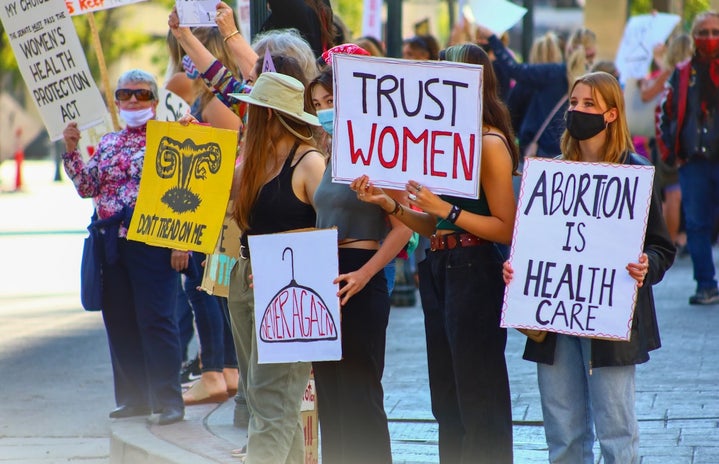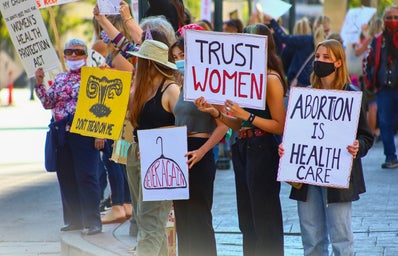In June 2022, the legal right to abortion fell in the United States with the overturn of Supreme Court case Roe v. Wade, which had enshrined the right to abortion for approximately fifty years. Since its overturn, both abortion and anti-abortion rights supporters and activists have frantically scrambled to act, resulting in a tumultuous political landscape and shifting state laws. In the post Roe v. Wade U.S., 14 states have enacted near and/or total bans on abortion, Alabama has ruled that embryos created through reproductive technology IVF are considered children under the state’s Wrongful Death of A Minor Act, and doctors are fleeing states with abortion bans. In addition, women are being accused of crimes such as tampering with a corpse after miscarrying as well as being forced to carry non-viable pregnancies to full term due to the fact doctors could face severe legal repercussions for providing medical treatment for miscarriages. Abortion rights activists and anti-abortion supporters continue to wage legal battles against one another, with abortion rights voters outperforming anti-abortion voters at the ballot boxes and pro-choice activists already laying the groundwork for the battle to re-establish the human right to abortion in the U.S. Although today the right to abortion is a contentious point in American politics, possessing the immense power to sway voters away from their chosen political party, abortion in early U.S. history was once a normal part of medical care. In an article recounting early American views of abortion, Irin Carmon, author of Notorious RBG: The Life and Times of Ruth Bader Ginsburg, reveal that abortion was considered permissible until “quickening” or fetal movement, and she notes that even the Catholic Church believed this was permissible. So why has abortion become one of the most controversial voting issues in America?
As Irin Carmon and Sarah Churchwell, professor at University of London, point out, the U.S.’s turn towards banning abortion in the 19th century was largely surrounded by arguments of nativism and white supremacy, as well as a fear of “women’s growing independence and the country’s growing diversity.” Carmon lists some of the figures who exemplified the growing nativism in the U.S. in the early 19th century, beginning with Dr. Horatio R. Storer, a major figure in fighting against the human right to abortion, who claimed that the future of America rested upon white women who could determine if America was filled with the children of white families or, in Storer’s words,“aliens.” Churchwell similarly argues that this nativist fear carried on into the 20th century, highlighting the fact that in 1973, —the same year Roe v. Wade was established— the far right’s great replacement theory, a theory which contends there is “a global conspiracy to replace white people with people of colour,” gained momentum throughout the U.S with figures such as Theodore Roosevelt arguing that white women needed to have “native” children and saying things such as, “I believe in children. I want to see enough of them and the right kind.” Churchwell argues that these fears, rooted in white supremacy, have carried into today’s anti-abortion campaigns, with Republican congresswoman Mary Miller speaking on behalf of all MAGA supporters, thanking the U.S. Supreme Court justices who created “the historic victory for white life in the supreme court.”
Similarly, as Annalies Winny recounts in her Brief History of Abortion, another reason abortion moved away from being a “quiet reality” of American life was physicians’ determination to regulate medication and create a medical environment that excluded women and Black people from offering their medical services. Until the 19th century, abortion had been a women’s area of medical expertise, with abortions largely being conducted by midwives who sold “abortifacients and pessaries” that induced miscarriage and who performed “dilation and curettage” surgeries. Yet when the AMA, a white-male medical association, established itself in 1857, it created a campaign that asserted “life begins at conception, rather than quickening” in order to prevent anyone outside the AMA (e.g. women and people of color) from offering these services. Winny similarly argues that the push against abortion was heightened by the shift that occurred after World War II when women were increasingly encouraged to remain in the home and the baby boom took place. During this period, there were approximately 42 million births.The overturn of Roe v. Wade resulting in the removal of the constitutional human right to abortion is deeply intertwined with an “oppressive history of control over women, colonization and slavery.” Since these events, maternal mortality rates have been on the rise in the U.S., particularly among Black women and people, Hispanic women/people, Indigenous women/people, and women/people from low-income backgrounds. The Supreme Court’s overturning of Roe v. Wade has and will continue to affect the physical and psychological well being of individuals across the nation who are forced to give birth, miscarry, and suffer severe health problems against their will that will and irrevocably alter the courses of their lives. Similarly, women who are able to acquire abortions outside their home state in states where abortion remains legal will be forced to utilize financial resources to travel and/or acquire illegal abortions. Although abortion has become illegal and/or almost entirely banned in many areas throughout the U.S., the fight for reproductive rights and in turn, the human right to control one’s own body and life, is far from over. Although some states have begun banning abortions, abortion rates continue to remain steady as they rise in states where abortion is legal and activists are continuing to fight to broaden abortion access. For example, retail pharmacies such as CVS and Walgreens are now allowed to offer prescribed abortion medications such as Mifepristone under new F.D.A regulations. In spite of the ensuing attacks from the right, 80% of Americans believe that abortion should be legal and pro-choice activists, advocates, health care providers and people across the country are ready to fight for the human right to choose what happens to one’s own body and life.


